Behold the resinous polypore, inspiring chefs around the world with it's seductive, appealing name! Probably not. Either way, this is an interesting mushroom you've probably seen but never thought about eating.
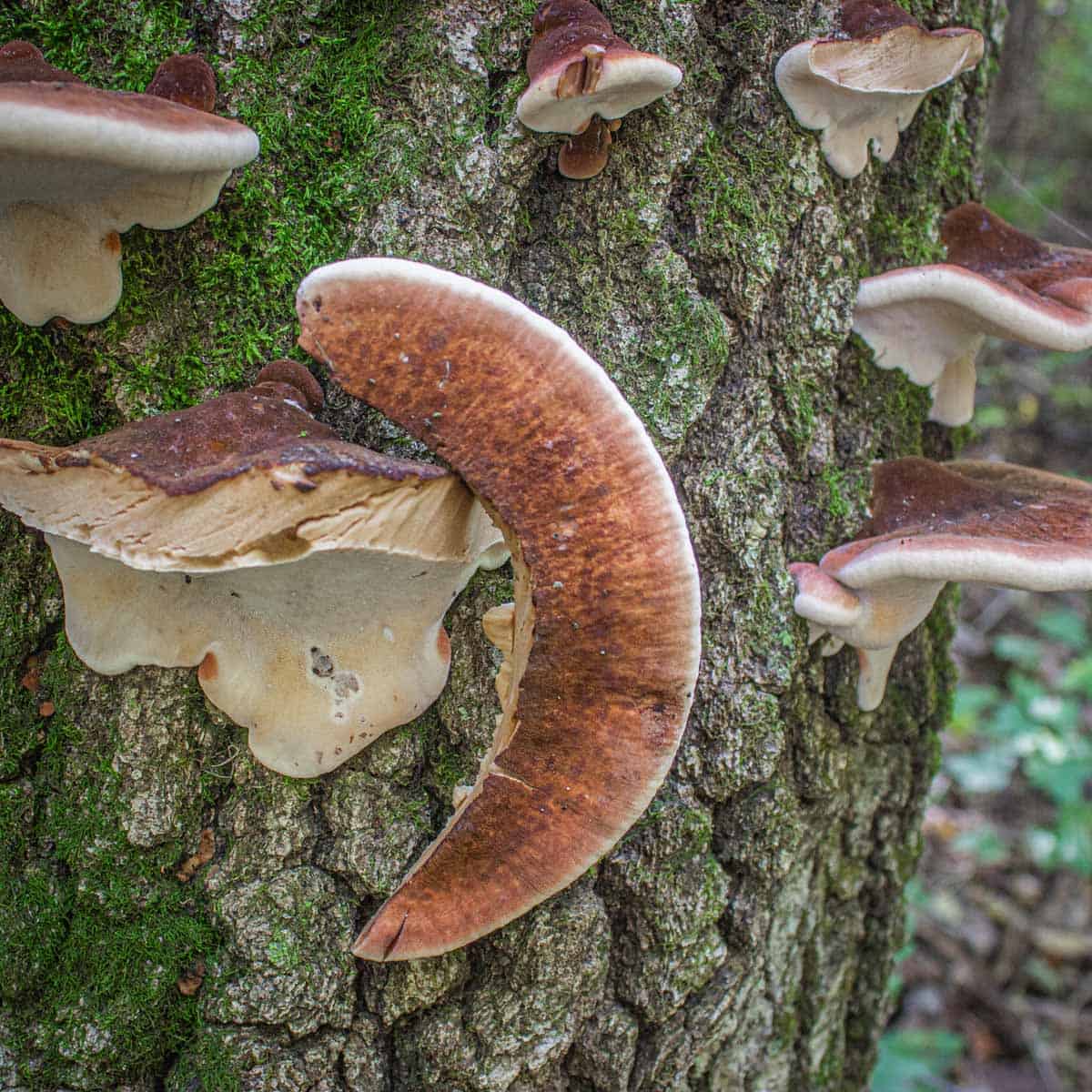
When I first started cooking with this mushroom, I'd never seen it in a field guide, or heard anyone else talk about it as an edible, I just used my chef intuition. As far as I know, I'm the first person to spread the message about eating resinous polypores, and, now years after I first put this post up, plenty of people have come to enjoy this mushroom, that you can get for free, in your local woods.
Ischnoderma resinosum grows on hardwoods and conifers (I have only seen it on hardwoods in Minnesota). If you've seen it, you've probably passed it by thinking that it looks too hard to even be edible, and you would be correct, if it's mature, and has been growing for a while.
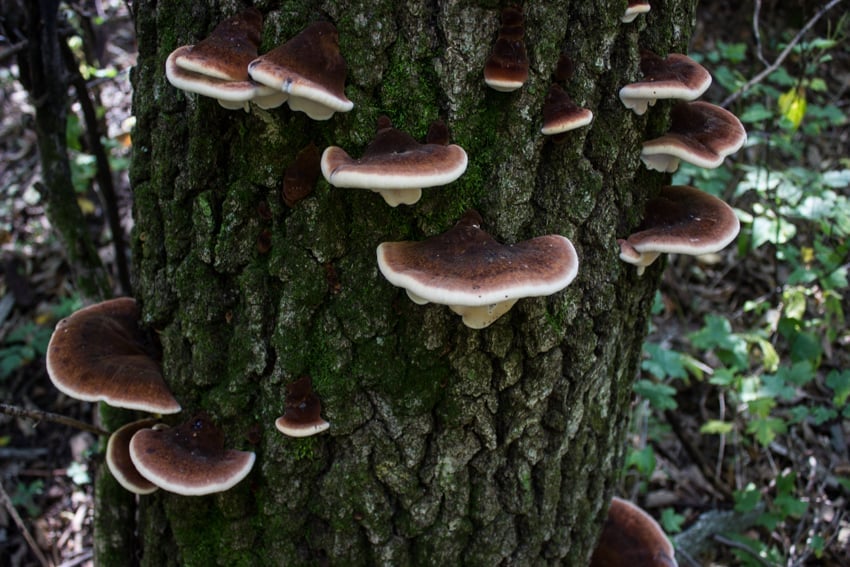
Harvesting
Just like vegetables and animals, the age of mushrooms has a lot to do with how good they will taste. An old lamb will have a much stronger flavor from a young one, and a cauliflower left to bolt and flower will be much more bitter than one that's younger.
Our resinous polypore here is the same. Older resinous polypores will be tough, like a wood plank, and pretty much impossible to cook with-I used to think they were a novelty, like Ganoderma applenatum/artist's conch, a mushroom that's only use is pretty much as tinder, or for drawing pictures on.
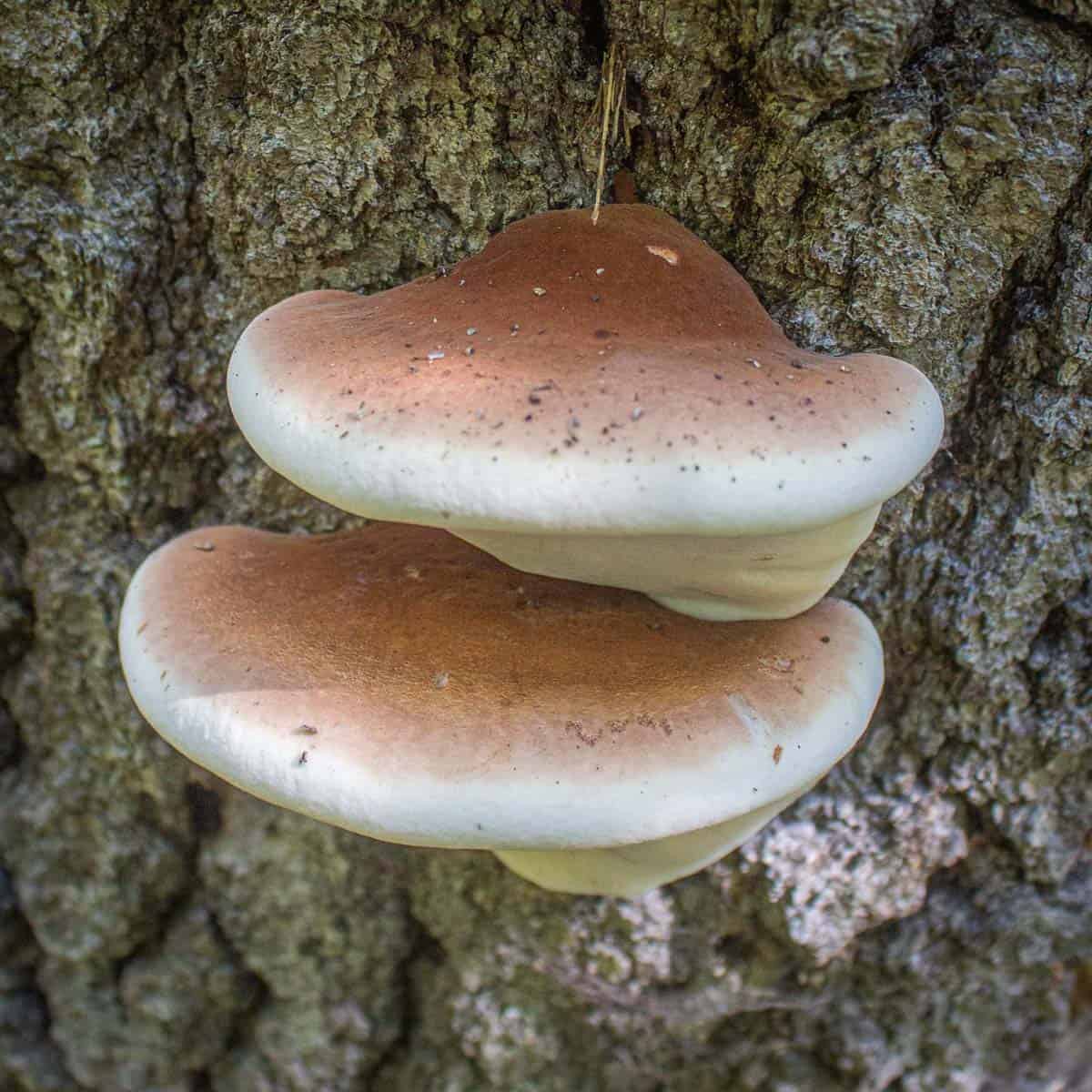
So one day I was out hiking and I spotted some very young Ischnoderma. I wasn't having much luck hunting other summer mushrooms, and I thought I would go check them out, for the lack of anything else growing nearby.
I remember touching some of the young mushrooms just budding from the tree and thinking to myself: "those feel sooo tender". My mouth started watering; I just knew I could eat them. If I know one thing about cooking with polypores, and mushrooms in general too, it's that the younger the mushroom, the more delicious it will be. Polypores in general are more generally safe too, from my experience.
Drying
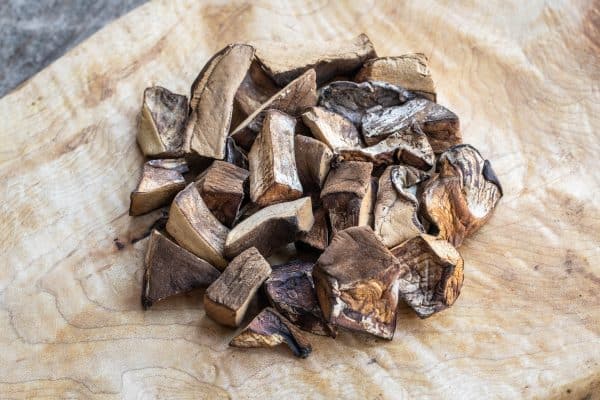
When you bring your resinous polypores home, even after you trimmed what appear to be the softest parts of the mushroom from the tree, you'll probably be left with a bit of woody trim.
There's no reason to throw those woody pieces out, and they will lend a great color to soups and broths, just like the tender pieces, with the bonus that you can hold them in the pantry instead of giving up valuable freezer real-estate.
Cooking
I took the ischnoderma home and got experimenting. After cleaning with a quick rinse, I made sure to trim them just like I would a chicken of the woods-using only the tender young margins, the closer it gets to the tree the more tough it will get.
In the kitchen the first thing I tried was the basic saute, I heated some grapeseed oil and threw them in the pan, added some salt after they started to brown, and finished with a knob of butter. They were ok, slightly chewy, and just ok.
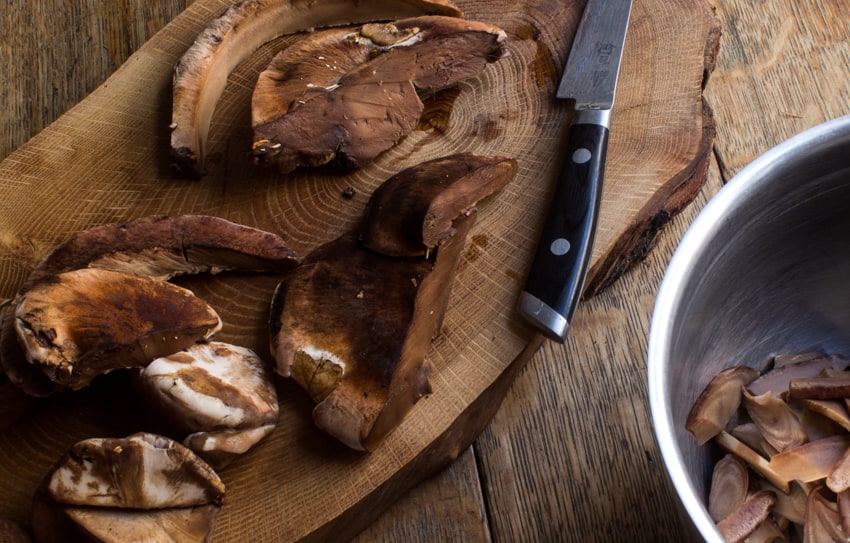
The second way I cooked them was stewing with some salt and herbs to release their juice, then reducing the juice, allowing the mushrooms to gradually caramelize in their own liquid.
After one taste of the second method, I was sold. Basically the Ischnoderma, like most mushrooms, has a lot of water weight. when that water is released and then concentrated, their flavor blooms and comes alive. The flavor is much richer than I expected, there's a deep richness to them, a great umami quality.
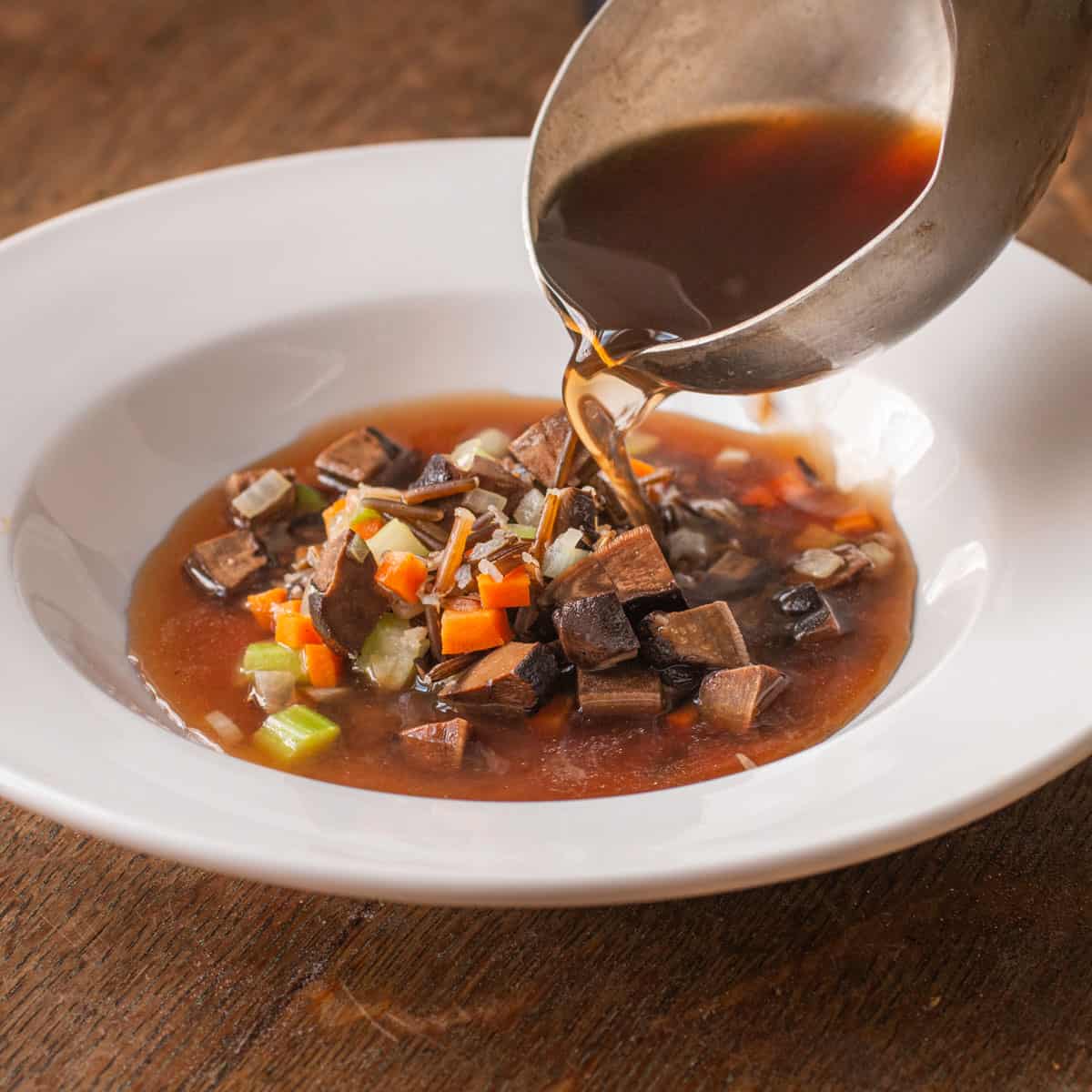
Taking into account their tasty liquid, I modified my older mushroom conserve / pickled mushroom recipe for them. The preserved mushrooms are great reheated gently and added to rice, pasta, or on top of a steak, it's one of the most basic and versatile recipes I know. You don't have to add the vinegar to the recipe, but the mushrooms will go bad in a couple days if you don't.
All of that being said"resinous polypore" is not doing it for me. I have yet to come across another common name for this mushroom, so I think we should come up with one. Considering how soft and velvety they were in their young state, "velvet polypore" sounded nice to me. Anyone else have some ideas?
Safety Note
My friend professor Greg Thorn recently mentioned to me that those of you who might see Ischnoderma species growing on conifers (Ischnoderma benzoinum) may want to proceed with caution. Just as conifer-eating Laetiporus huronensis (chicken of the woods) can give some people gastro-intestinal distress, it is possible the same could be true of Ischnoderma benzoinum.
That being said, years after I initially wrote this article now (and after discussing how much of an underrated edible Ischnoderma resinosum is with a host of mushroomers around North America), I haven't heard of a single instance of digestive problems with this species, yet. Keep in mind tolerances and sensitivities vary greatly from person to person with mushrooms.
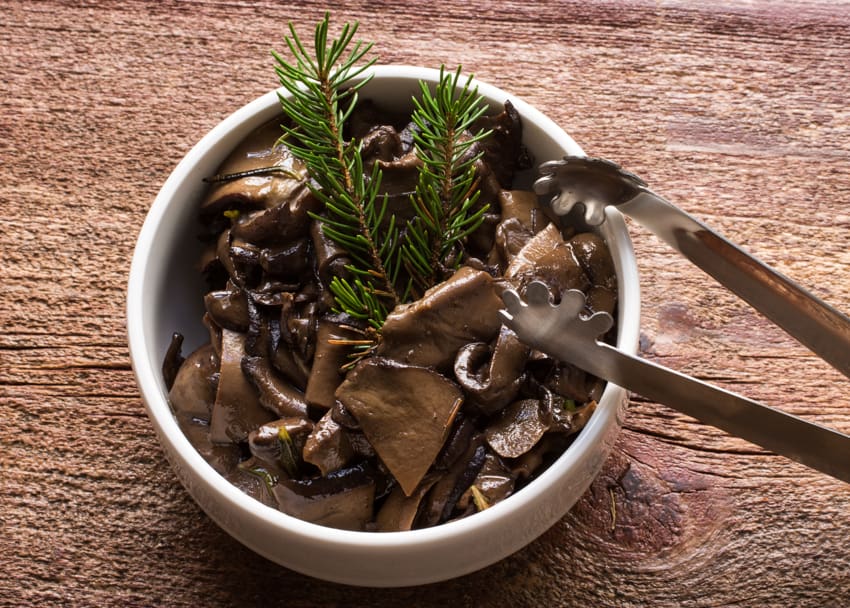
Ischnoderma Mushroom Conserve
Ingredients
- 3 lbs small young ischnoderma resinosum, tender ends only, cleaned and rinsed if needed.
- 3 large cloves of garlic sliced thin
- ¼ cup flavorless oil for sauteeing such as grapeseed or canola
- ¼ cup flavorful oil such as extra virgin olive oil, virgin sunflower oil, or a tasty nut based oil, such as hazelnut
- Roughly ½ tablespoon of kosher salt
- 1 qts water or vegetable stock
- ¼ cup champagne vinegar or white vinegar.
- Large sprig of a hard herb like thyme, or rosemary. (You could also finely chop some of either and add it too, which will give it a stronger flavor.)
- 2 fresh bay leaves
- Tiny pinch of cayenne or red pepper flakes
Instructions
- In a wide pan with high sides, or even a soup pot, gently heat the oil and the sliced garlic until the garlic begins to turn golden.
- Add the mushrooms, salt and herbs, and allow the mushrooms to give up their juice and stop the garlic from getting too brown. Stir the mushrooms to coat them with the garlic, herbs and oil, and season them with a pinch of the salt.
- Continue mushrooms until most of their liquid has evaporated, about 10 minutes, then remove and discard the herbs. Add the court bouillon or water.
- Add the vinegar and flavored oil of your choice. Simmer the mixture for a few minutes, then taste the liquid, and adjust with salt if needed.
- Finally, put the conserve into a container and refrigerate. If you will be keeping the conserve for more than a few weeks, make sure to put plastic wrap on top of the conserve to keep the mushrooms under the liquid, to ward off bacteria. Under the liquid though they will keep for a few months. You could also freeze the mushrooms in a container or freezer bag, with their liquid.

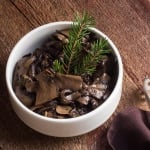
Julia
Thank you for this post. I’ve come across these and some young species too thinking that I haven’t seen once that they are edible. But they looked so soft and tender. Next time I see them I’m going to try
Alan Bergo
You won't be disappointed
Damian Pieper
I was the president of The Prairie States Mushroom Club for 5 years and also the editor of "Symbiois", the club newsletter for 5 years. I discovered Ishnoderma resinosum many years ago. The first time that I cooked it, I sautéed it and covered it with a brown gravy. It not only looked like roast beef and gravy but tasted so much like roast beef that ever since I have called it the "roast beef mushroom". At the time, no reference book we had suggested any English nickname for it so "roast beef mushroom" caught on and is still used here in Iowa. I still call it that because it not only seems to describe the umami flavor it has, but also suggests some of the best ways to cook and serve it.
Alan Bergo
Roast beef mushroom is a great idea.
Jes
Love the name velvet polypore!
Thanks for taking the time to share; I have always seen them while collecting Birch Polypore, but until now did not know what to do with them.
Conserve is great.
Kate ONeill
Can I can these to preserve on shelf?
Yulia
Thank you for this post, i am planning to cook my find:-) "Velvety polypore" - that is exactly what I was searching it under, while trying to ID:-)
Alan Bergo
Salisbury steak of the woods was one I heard recently.
Perry
I brought a young specimen into a Mn Myco Society last month for an ID. There was a discussion about slow cooking them for several hours to yield a 'beef broth' tasting liquid. Did your broth taste beefy?
(I have two in my basket as we speak!)
Alan Bergo
Perry that sounds like such a good idea! I'm going to have to try that next time I find some. Thank you.
Perry
You are very welcome, but I must say that I am very intriqued by this recipe you posted for eating the young flesh. Sounds scrumptious!
Ashleigh
LOVE the name! "Velvet" sounds so much better than "Resinous" in my book! I must say, you are the only forager/chef I've ever seen actually harvest & cook with Ischnoderma (besides me)...and the edibility/identification information found on this fungus leaves much to be desired, which is most likely the reason you won't find other (more appetizing) common names out there. Thanks for sharing! And, I'll definitely start calling them Velvet Polypore. Let's see if it catches on! 🙂
Zach Farrell
At first it says the recipe is a restaurant batch of 5 lbs., then the recipe begins and says 3 lbs. Should we assume it's the latter? I just located some of these and I am really excited to try them!
Alan Bergo
Yes, a simple typo, use 3 lbs.
lamb
thanks so much
harvested 27 pounds live weight
and was looking for ideas
they make a great tea too
the older ones I dried, ground then perked
dark and sweet
thanks again
Robert
This mushroom is ridiculously good. With a young one, it is more intensely mushroomy than the best boletes. Definitely my favorite mushroom now, and abundant here in NY.
Rob
I'm wondering if you have tried this with Ischnoderma benzoinum too. Also, have you tried cooking with Ganoderma spp., such as G. tsugae? We have a lot of those in my area.
Alan Bergo
Hi Rob, I have not cooked I benzoinum, or Ganoderma sp.
Ashleigh
I have experimented with Ganoderma sp. in the kitchen. I was apprehensive, as I had always heard they were very bitter and only used for medicinal purposes (tea, tincture, etc)...but if you harvest young, tender specimens, and only use the soft outer edges (just as with Resinous Polypore), they are "ok." Nothing to write home about...but ok, and weren't bitter at all. They are fairly bland in flavor, so unless you have a reason to cook them (other than curiosity), I'd stick to dehydrating them and just use for tea or broth.
Beq
Funny, I found some myself on 10/18/15. Didn't realize they were edible, so left them alone. Thank you for sharing. I may go back next year for the young mushrooms, which are as you say velvety - I'm in favor of the name change!
Alan Bergo
I know! Velvet polypore sounds sooo much better than ischnoderma.
Lisa Solomon
The recipe doesn't indicate at which step to add the water.
Alan Bergo
Thanks, I adjusted that. Part of the fun of not having an editor.
Nancy | Ramsons & Bramble
What a timely post! My boyf just brought one of these home and asked what it was. Had no idea until this landed in my inbox. It's a young 'un too.